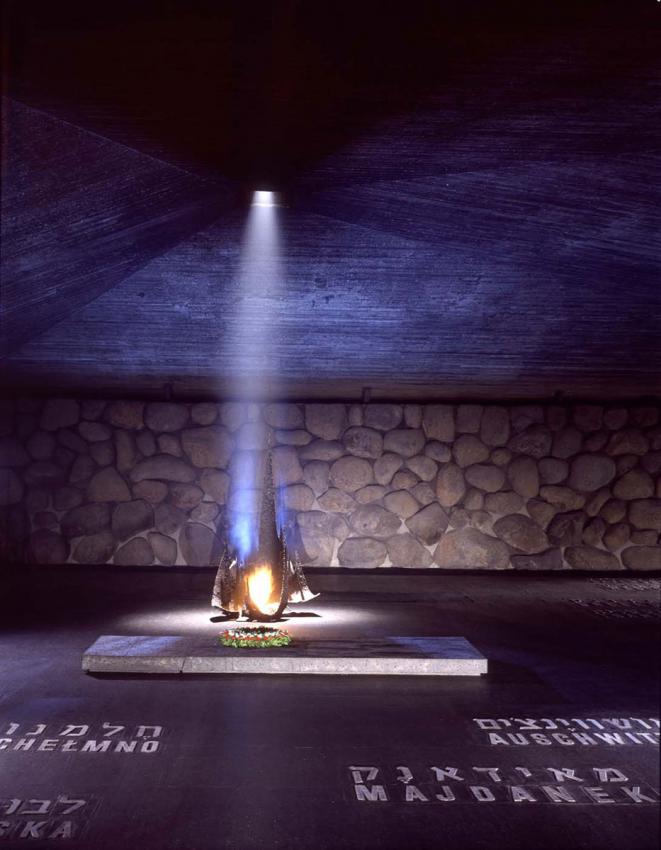11 July 2022
The President of the United States of America Joe Biden will visit Yad Vashem, the World Holocaust Remembrance Center, on Wednesday, 13 July 2022. Yad Vashem Chairman Dani Dayan and Holocaust survivor and Chairman of the Yad Vashem Council Rabbi Israel Meir Lau, together with the President of the State of Israel Isaac Herzog and Israel's Prime Minister Yair Lapid will participate in a memorial ceremony together with President Joe Biden, US Secretary of State Anthony Blinken, US National Security Advisor Jake Sullivan and US Special Envoy to Monitor and Combat Antisemitism Amb. Prof. Deborah Lipstadt. The visit is scheduled for 17:30.
During the memorial ceremony, the President will rekindle the Eternal Flame and lay a wreath on a slab under which ashes of Holocaust victims from the extermination camps are buried. The Ankor Children's Choir will sing "Walk to Caesarea" written by Hannah Szenes, and Cantor Shmuel Berlad will recite El Maleh Rachamim, a Jewish prayer for the souls of the martyrs of the Holocaust.
In the Hall of Remembrance the President will shake the hands of two Holocaust survivors: Rena Quint and Giselle (Gita) Cycowicz.
At the conclusion of the visit, President Biden will sign the Yad Vashem Guestbook outside the Hall of Remembrance.
Yad Vashem will broadcast the Memorial Ceremony in the Hall of Remembrance live via its YouTube Channel and Facebook page and the GPO Press Office.
Journalists covering the visit from the area of Warsaw Ghetto Square must arrive at Yad Vashem between 15:00-16:30. No entrance to Yad Vashem will be permitted after 16:30.
Due to security considerations for the visit of President Biden, Yad Vashem will be closed to the public on Wednesday, 13 July 2022.
The President's visit to Yad Vashem will be open to POOL coverage only.
International Media TV Pool: AFP TV – Ahikam Seri
International Media Stills Pool: AFP – Menachem Kahana & UPI – Debbie Hill
International Media Print Pool: Maayan Hoffman – JNS
Information about the two Holocaust survivors:
Giselle Cycowicz
Giselle (Gita) Cycowicz was born in 1927 in the town of Chust in the Carpathian Mountains, then part of Czechoslovakia. She grew up in an observant and Zionist Jewish home. When the Nazis invaded in 1944, the Jews of Chust were rounded up and confined in the ghetto established in the town. Shortly thereafter, Gita was deported to Auschwitz-Birkenau, and later to forced labor camps, ultimately surviving the atrocities and the inhuman living conditions. In 1948, Giselle, her mother and her two sisters, immigrated to the United States.
Rena Quint
Rena Quint was born as Freida "Freidel" Lichtenstein in December 1935 in the city of Piotrkow Trybunalski, Poland. In 1939, when Rena was three years old, the Nazis invaded and occupied her hometown. In October 1942, her mother and her two older brothers were deported to the Treblinka extermination camp, where they were murdered. Rena, who was not yet seven years old, was deported with her father to the Buchenwald concentration camp, where she was disguised as a boy in order to survive. When Rena's father was murdered, she was left alone in the camp. She was eventually sent to the Bergen-Belsen concentration camp.
At the end of the war, Rena went to Sweden, where she was adopted by a Holocaust survivor who passed away a few months later. In 1946, Rena immigrated to the United States with an adoptive mother, also a Holocaust survivor, who also passed away three months later as a result of her poor physical condition. Ultimately, Rena was adopted by a childless Jewish couple from Brooklyn, NY.
To read more about Rena's story >>>
About Yad Vashem
Yad Vashem, the World Holocaust Remembrance Center, was established by the Israeli Knesset (Parliament) in 1953. As the world's largest and preeminent Holocaust institution, Yad Vashem maintains the most extensive collections of Holocaust-era artifacts, documentation and artworks worldwide, which serve as the foundation for its activities both on the Mount of Remembrance in Jerusalem, around the world and in the digital sphere. Yad Vashem's educational methodology integrates a multigenerational and interdisciplinary approach to telling the story of the Holocaust as a unique and unprecedented event perpetrated against the Jewish people, as well as its universal significance. For more information, visit www.yadvashem.org
Hall of Remembrance
The Hall of Remembrance was the first commemoration site established at Yad Vashem on the Mount of Remembrance. Its walls are made of basalt boulders brought from the area surrounding the Sea of Galilee, and its angular roof gives it a tent-like shape. Engraved on the mosaic floor are the names of 22 Nazi murder sites, symbolic of the hundreds of extermination and concentration camps, transit camps and killing sites that existed throughout Europe. The Eternal Flame continuously illuminates the Hall, its smoke exiting the building through an opening at the highest point of the ceiling. Before it stands a crypt containing the ashes of Holocaust victims.







